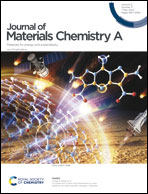Constructing an inorganic-rich solid electrolyte interphase by adjusting electrolyte additives for stable Li metal anodes†
Abstract
Li metal anodes are considered among the most ideal candidates for next generation batteries owing to their lowest electrochemical potential and high theoretical capacity. However, the highly reactive Li metal is subject to continuous side reactions with conventional carbonate electrolytes. The resulting unsatisfying solid electrolyte interface (SEI) induces severe Li dendritic growth. Therefore, there is an urgent need to effectively control the components of SEI to solve the electrolyte/anode interface electrochemical instability. Herein, LiDFP and LiNO3 are introduced into the electrolyte to modulate the composition of the SEI. Owing to the lower lowest unoccupied molecular orbital (LUMO) energy levels of LiDFP and LiNO3 relative to those of the solvents, LiDFP and LiNO3 have preferential reducibility and thus generate a stable SEI containing LiF and Li3N, which has swift ion migration kinetics and homogeneous Li deposition behaviors. As a result, our electrolyte modified by additives enables the anode to achieve an excellent coulombic efficiency of 98% and exhibits an ultra-long cycling life of over 700 h in symmetrical cells. Li metal full cells paired with the LFP or NCM811 cathode also have excellent long cycling performance. This work demonstrates that additive-modified electrolytes are a viable and simple strategy for the evolution of Li metal batteries.

- This article is part of the themed collection: 2024 Journal of Materials Chemistry A HOT Papers


 Please wait while we load your content...
Please wait while we load your content...